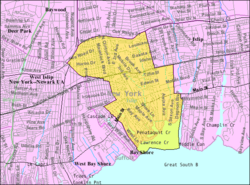Bay Shore, NY
| Bay Shore, New York | |
|---|---|
| Hamlet and census-designated place | |

Bay Shore Marina
|
|
| Motto: The Heart of the South Shore | |
 U.S. Census map |
|
| Location within the State of New York | |
| Coordinates: 40°43′47″N 73°15′13″W / 40.72972°N 73.25361°WCoordinates: 40°43′47″N 73°15′13″W / 40.72972°N 73.25361°W | |
| Country | United States |
| State | New York |
| County | Suffolk |
| Area | |
| • Total | 5.5 sq mi (14.3 km2) |
| • Land | 5.4 sq mi (13.9 km2) |
| • Water | 0.2 sq mi (0.4 km2) |
| Elevation | 16 ft (5 m) |
| Population (2010) | |
| • Total | 26,337 |
| • Density | 4,800/sq mi (1,800/km2) |
| Time zone | Eastern (UTC-5) |
| • Summer (DST) | EDT (UTC-4) |
| ZIP code | 11706 |
| Area code(s) | 631 |
| FIPS code | 36-04935 |
| GNIS feature ID | 0943194 |
Bay Shore is a hamlet and census-designated place (CDP) in the Town of Islip, Suffolk County, New York, United States. It is situated on the South Shore of Long Island, adjoining the Great South Bay. In 2008, Bay Shore celebrated the 300th anniversary of the purchase of the land from the Secatogue Native Americans. The population of the CDP was 26,337 at the time of the 2010 census.
Bay Shore is one of the older hamlets on Long Island. Sagtikos Manor, located in West Bay Shore, was built around 1697. It was used as a British armed forces headquarters, at the time of the Battle of Long Island during the Revolutionary War. President Washington stayed at the manor during his tour of Long Island in 1790.
The land that would become Bay Shore proper was purchased from the Secatogue Native Americans in 1708 by local school teacher John Mowbray for "several eel spears".
The hamlet's name has changed over time: Early European settlers referred to the area first as Penataquit and later as Awixa; both were names used by the Native American Secatogue tribe. For reasons never documented, the name was changed in the early 19th century to Sodom. In 1842 there was a further name change to Mechanicsville, then a return in 1849 to Penataquit. The name Penataquit proved unpopular because it was difficult to spell. The name of the hamlet and post office was changed to Bay Shore in 1868.
Bay Shore became renowned in the late 19th century for its shopping district and resorts. The rural hamlet became popular with affluent New Yorkers looking to escape the city to white sand beaches of the Great South Bay and the fishing villages of Fire Island. It was a tourist spot on weekends and during the summer, in large part because the newly built Long Island Rail Road enabled easy access from New York City. During World War I it became the headquarters of the First Yale Unit, a United States Naval Air Reserve unit.
...
Wikipedia

